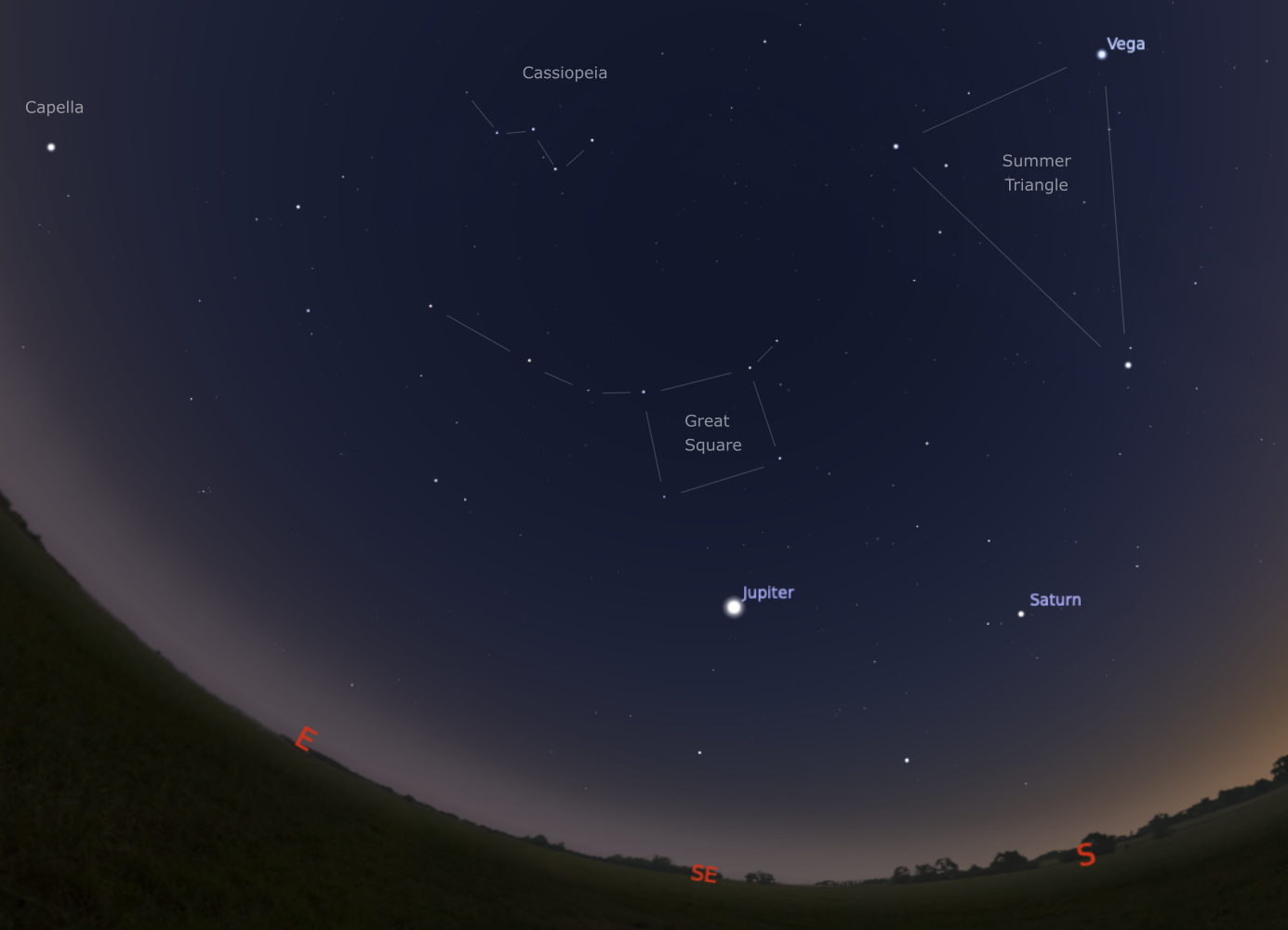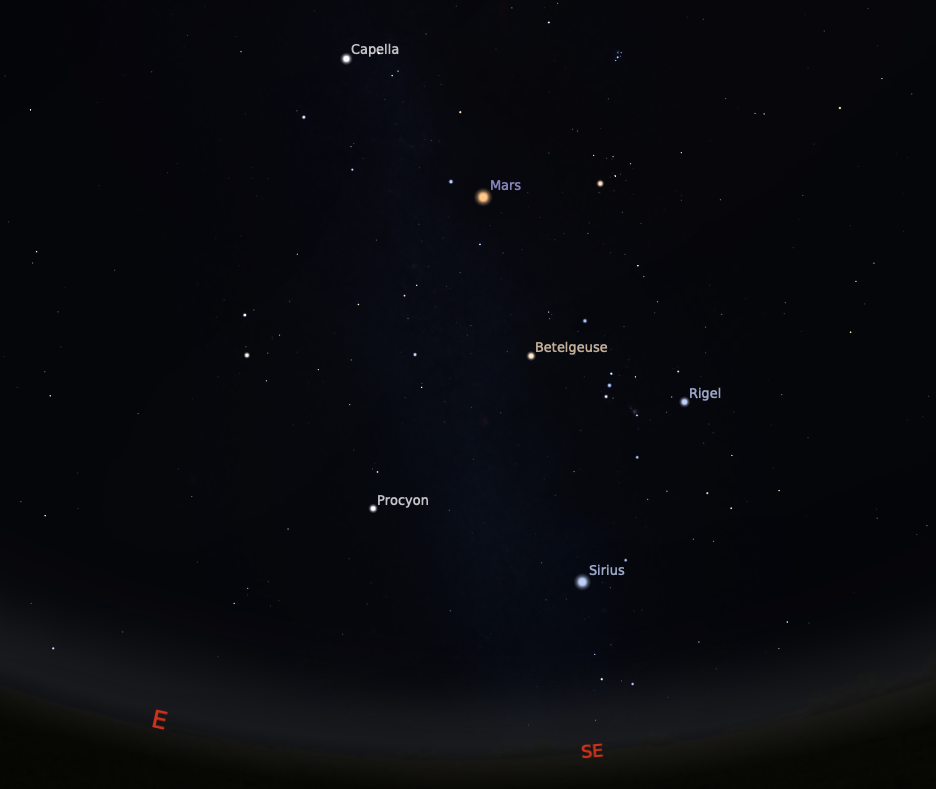Targeting Mars
Nov 23, 2022
Hi Everyone!
I really was going to try to keep it brief this time. I just wanted to draw your attention to a few pretty stars and planets that you can look for while you are out on your evening stroll over the Thanksgiving holiday (or anytime in the next few weeks). But I also discovered that something very rare and special is going to happen to one of the planets in a couple of weeks. Read on to find out what it is.
The Current Evening Scene
I hope you were able to enjoy the recent lunar eclipse. I didn't think I would be able to, on account of clouds, but the skies cleared and I actually had a lovely view. Today, one fortnight and one half of a lunar cycle since the eclipse, is the day of the November new moon. This means that in another day or two, we should start seeing the lovely whisper of a crescent moon hanging out over the sunsets. This is the beginning of a new cycle, and a good time to start watching for the moon in the evenings.
If you go out for a stroll at dusk in the next week hoping to find the moon, look around for bright stars and planets. There are several landmark constellations (if there can be such things as “landmarks” in the sky) for you to practice your constellation identification skills. There are also a couple of bright “misplaced stars” (i.e. planets) to locate, and perhaps to enjoy through a telescope.

(I apologize to my readers who live near the Equator or in the Southern Hemisphere, but I myself and most of my readership live in the northern mid-latitudes, so I am focusing my description on those latitudes. You can still see many of the same constellations and all of the same planets, but if you live near the Equator you will have to imagine them arcing overhead instead of across the southern sky, and if you live in the Southern Hemisphere, you will have to imagine them flipped all the way over and spread backwards across your northern sky.)
If you look straight up (in northern latitudes), you will see the “Great Square of Pegasus” and the graceful arc of Andromeda gradually replacing the “Summer Triangle” at the top of the sky. The Summer Triangle is still not too far from overhead in the evenings, although it is rapidly sliding down the western sky as we head into winter, and the Great Square is rising to replace it from the east. One of the brightest stars in the sky is Vega, forming one corner of the Summer Triangle, and if you look low and to the northeast, you will see another of the brightest stars in the sky: Capella.
Perhaps you are wondering as my students sometimes would: Why do we call it the “Summer Triangle” when we are so close to winter? Part of the reason is that the shortening daylight has been pushing our “evening stargazing” times earlier and earlier in the day for several months now. The Summer Triangle is high overhead in the evenings of late summer, but now, if you wait until the same time of day when the sun would have set if it were still summer, you will see that the Summer Triangle is much lower, setting in the west.
Also, if you'd like a fun labeling and coloring activity to do with your kids, may I suggest my own constellation worksheets? There is one for the Summer Triangle, and another for the Andromeda story, including the Great Square.
Among the normal “fixed stars” that form the constellations, you may also notice an extra star over the southern horizon, and another very bright misplaced star a little to the left, in the southeast. If you try to locate these stars on a printed constellation map, you won't find them. These are “wandering stars,” or planets. The bright one in the southeast is Jupiter, and the one in the south is Saturn. If you happen to own a telescope, try setting your sights on these two, and see if you can discover any remarkable features.
If you wait until several hours after sunset, after Capella has risen much higher in the sky, you will notice that Capella is just the leading edge of a giant ring of some of the brightest stars in the sky. This majestic raft of constellations is known as the “Winter Circle” or “Winter Hexagon,” and it will become much more prominent in the evening skies over the next couple of months. (I have a constellation worksheet for this useful “landmark” in the sky as well.) If you have dark skies, you might also be able to see the gorgeous river of milky haze running up through the middle — The Milky Way.

If you are up late enjoying the majestic beauty of the Winter Hexagon, you will probably notice another very bright misplaced star inside the ring. This one is distinctly red, and it isn't usually this bright, but every 2½ years or so, it flares up like an angry god of war. This is Mars, and it “flares up” every time it is at opposition. Notice that Mars rises in the east just as the sun sets in the west. Mars is currently on the opposite side of the sky, and thus also on the opposite side of the Earth, from the sun. (The date of exact opposition is December 8th, but Mars is already pretty close to this point.) You might also notice that Mars, and the point of opposition, are inside the Winter Circle. Perhaps for the next month we can think of this grand celestial ring like a target, and anything that “hits” the middle of the target will be at opposition? (Pop quiz: What will happen to the moon when it reaches this point?)
Notice that Mars, Jupiter, and Saturn form a long arc in the evening sky, stretching across the sky from east to west. If you watch the moon for the next two weeks, you will notice that it gradually marches “backwards,” i.e. from west to east, and it will pass right along this arc, like it is driving down some kind of “planet highway” across the sky. The moon will pass Saturn on the 29th, it will make a striking conjunction with Jupiter on December 1st … and look out on December 7th-8th, because that's when the fun happens!
A Celestial Collision
In another two weeks (and one lunar cycle since the eclipse) the moon will have crossed the sky, it will reach opposition, and it will become full again, just a day before Mars reaches opposition. When the moon “passes” Jupiter and Saturn along the “highway”, it will come close to those planets in the sky, but will never touch them, as if it is in the passing lane of the highway. But when the moon finally reaches Mars, it won't be able to steer clear, and it will hit Mars! Actually, it will pass in front of Mars and temporarily hide it from view. The technical name for this “eclipse of a planet” is “occultation”. On December 7th-8th, the full moon will occult Mars.
Unfortunately, eclipses of planets are like eclipses of the sun — only a small part of the world can see each one. People living in other parts of the world will see the moon pass very close to the planet, but never touch it. Fortunately (for most of you reading this) the upcoming occultation of Mars will be visible across most of the United States and Europe. In a nutshell, residents of western and central United States will see the event take place while the moon is rising in the eastern sky in the late evening of December 7th. Residents of Europe will see it virtually simultaneously … but from that viewpoint, it will be a few hours before dawn on the 8th, and the moon will be low over the western horizon. If you do not live in North America or Europe, you may still want to pay attention at that time. The sight of the moon very close to a bright planet can still be impressive.
For local details regarding timing and visibility from your location, you may want to search your local media, especially web pages for local planetariums. The Adler Planetarium has a nice page with information for the Chicago area. If you can convert a Universal Time into your local time, then you may find the lunar-occultations website to be helpful. There is a map, and a long list of cities around the world, and the entry for each city gives event times (in the “h”, “m”, and “s” columns) for the occultation, in Universal Time. The first third or so of the page gives a list of “disappearance times,” i.e. times when the moon will first hide Mars. If you scroll about one-third of the way down the page, you will find the beginning of the list of “reappearance times,” when Mars will re-emerge from behind the moon. In the table, there is also an “Alt” column for the sun, which is mostly empty but contains a few negative numbers. The negative numbers give the number of degrees that the sun is below the horizon, thus indicating the amount of twilight you will have to deal with. If the entry is blank, that means the sun is so far below the horizon that there is no twilight. There are also “Alt” and “Az” columns for the moon, if you want to know exactly where to look for it in the sky … although the full moon should be pretty obvious and easy to find.
So, if we are thinking of the Winter Hexagon like a target ring, not only will the moon and Mars both reach opposition when they pass across the middle of the target, the moon will actually strike Mars when they are there!
Good viewing!
John